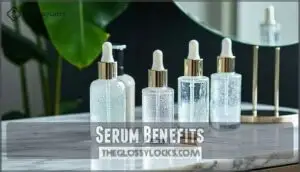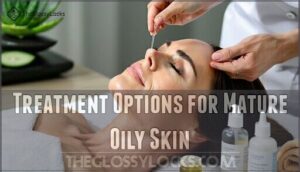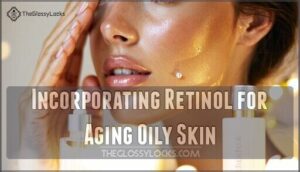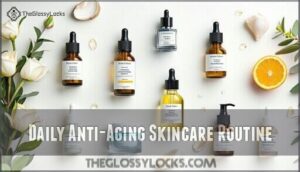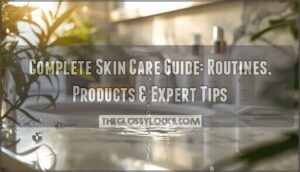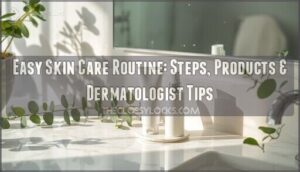This site is supported by our readers. We may earn a commission, at no cost to you, if you purchase through links.

Start with a gentle, oil-controlling cleanser that won’t strip your skin. Follow with a lightweight toner containing salicylic acid to unclog pores.
Apply a serum with retinol or vitamin C for anti-aging benefits, then finish with a non-comedogenic moisturizer.
The secret sauce? Niacinamide helps control oil while minimizing pores. Don’t skip sunscreen during the day—it’s your best anti-aging weapon.
Remember, oily skin still needs hydration, just in lighter formulas. The right ingredients can work double duty for your skin concerns.
Table Of Contents
- Key Takeaways
- 7 Best Cleansers for Aging Oily Skin
- Toning: Murad Clarifying Facial Toner
- Serum Selection for Aging Oily Skin
- Treatment Options for Mature Oily Skin
- Incorporating Retinol for Aging Oily Skin
- Daily Anti-Aging Skincare Routine
- Frequently Asked Questions (FAQs)
- Is oily skin good for anti aging?
- What is the best treatment for mature oily skin?
- Does oily skin need retinol?
- What are the benefits of using a toner?
- How do you know if you have oily skin?
- What are the best natural ingredients for oily skin?
- How often should you exfoliate?
- Can you use retinol every day?
- How often should I exfoliate oily aging skin?
- Can I use face oils with oily skin?
- Conclusion
Key Takeaways
- You don’t need to choose between fighting wrinkles and controlling oil – ingredients like niacinamide, retinol, and salicylic acid work double duty to address both concerns simultaneously.
- Start with gentle, oil-controlling cleansers and lightweight formulas that won’t strip your skin’s natural barrier, then layer products from thinnest to thickest consistency for maximum absorption.
- Incorporate retinol gradually into your nighttime routine, beginning with 0.25% concentration once weekly and slowly increasing frequency as your skin builds tolerance to avoid irritation.
- Never skip sunscreen during the day – it’s your most powerful anti-aging weapon, and consistent use of broad-spectrum SPF 30+ protects your investment in other skincare products.
7 Best Cleansers for Aging Oily Skin
Your skin’s needs change with age, making the right cleanser essential for managing oily, mature skin.
Choose gentle exfoliation with salicylic acid cleansers that unclog pores without stripping moisture. Look for cleanser ingredients like ceramides and niacinamide that maintain pH balance while providing oil control.
CeraVe Foaming Facial Cleanser offers anti-inflammatory benefits perfect for anti aging oily skin routines. La Roche-Posay Effaclar works well for sensitive types.
Remember, your oily skin care starts with the right cleanse – foam-based formulas remove excess sebum while protecting your skin barrier. For mature skin, consider using cleansers that offer collagen stimulation properties.
Toning: Murad Clarifying Facial Toner
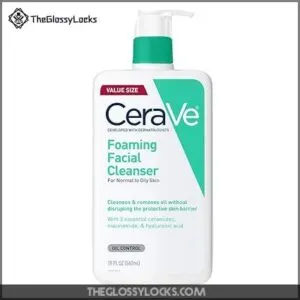
The right toner transforms your skincare routine from good to great. Murad Clarifying Facial Toner delivers targeted benefits for aging oily skin through carefully selected toner ingredients like witch hazel and salicylic acid for pore refining.
Here’s what makes this toner exceptional:
- Witch hazel acts as a natural astringent, tightening pores and controlling excess oil
- Salicylic acid gently exfoliates dead skin cells while unclogging pores
- Antioxidant-rich algae and grape seed extracts protect against environmental damage
- Balances skin pH after cleansing, preparing skin for better product absorption
- Application frequency of twice daily maximizes Murad benefits without over-drying
Apply with cotton pad after cleansing for ideal toner benefits.
Serum Selection for Aging Oily Skin
Selecting the right serum for aging oily skin means finding products that control oil while fighting wrinkles and fine lines.
You’ll want lightweight formulas with ingredients like niacinamide, hyaluronic acid, or retinol that won’t clog your pores but still target signs of aging.
Serum Benefits
After proper toning, your anti-aging skincare routine benefits tremendously from targeted serums.
These concentrated formulas deliver powerful ingredients that transform oily skin:
- Serum Hydration – Lightweight moisture without clogging pores
- Antioxidant Protection – Shields against environmental damage and premature aging
- Oil Control – Regulates sebum production while maintaining skin balance
- Pore Minimizing – Refines texture for smoother appearance
To combat aging signs, consider serums with key ingredients like retinol.
Choosing The Right Serum
Several serum ingredients target aging concerns while controlling excess sebum.
Look for vitamin C, retinol, and niacinamide in lightweight formulations. Serum texture matters—choose oil-free, fast-absorbing options that won’t clog pores.
Consider serum potency when starting your anti-aging skincare routine. Store products properly to maintain effectiveness.
These oil control skincare choices balance hydration without adding shine. Some serums even include hyaluronic acid benefits for added hydration.
Application Techniques
Once you’ve picked your ideal serum, mastering proper application transforms your skincare routine from basic to brilliant. Your oily skin deserves the full benefits these potent formulas offer.
Perfect Your Serum Application:
- Start Fresh: Cleanse thoroughly, then apply 3-4 drops to slightly damp skin. This moisture helps serums penetrate deeper while preventing that tight feeling.
- Layer Smart: Use the thinnest-to-thickest rule when layering products. Anti aging serums go first, followed by heavier treatments. Wait 60 seconds between each layer.
- Master Massage Techniques: Gently press serum into skin using upward motions. Focus on areas needing extra attention, but avoid harsh rubbing that stimulates oil production.
Remember: consistent tool usage and proper sunscreen reapplication complete your routine. Many users find success with advanced anti-aging options.
Treatment Options for Mature Oily Skin
When tackling oily aging skin, professional treatments offer targeted solutions beyond your daily skincare routine.
Hormonal influence and lifestyle factors contribute to excess oil production, but combination therapies can effectively address both concerns simultaneously.
Consider these professional treatment options:
- Dermatologist-designed regimens – Customized plans targeting your specific anti aging and oily skin needs
- Botulinum toxin treatments – Effectively manage excessive oil production in mature skin
- Photodynamic therapy – Advanced laser solutions for oily aging skin concerns
- Preventative measures – Professional guidance prevents future skin issues while treating current ones
A focus on natural anti-aging ingredients can complement these treatments.
Incorporating Retinol for Aging Oily Skin
Retinol transforms aging oily skin by reducing excess oil production while targeting wrinkles and fine lines. This powerhouse ingredient controls breakouts, minimizes enlarged pores, and smooths skin texture through improved cell turnover.
**Retinol is the ultimate multitasker – controlling oil, fighting wrinkles, and refining pores all at once.
One key benefit is that retinol can boost collagen and elasticity, leading to firmer skin.
Here’s your complete retinol incorporation guide:
- Start with lower Retinol Strength (0.25%) to build tolerance
- Begin with once-weekly Application Frequency, gradually increasing
- Apply pea-sized amount to entire face during nighttime routine
- Use after cleansing but before moisturizer application
- Monitor skin for initial irritation or contact dermatitis signs
- Pair with hyaluronic acid for Irritation Management and hydration
- Combine with ceramides to strengthen skin barrier protection
- Add peptides for enhanced anti-aging benefits without irritation
- Include bakuchiol for gentle retinol-boosting Product Combinations
- Always apply broad-spectrum sunscreen during daytime hours
- Avoid mixing with vitamin C in same application
- Allow 4-6 weeks to see visible Long-Term Benefits
- Increase frequency based on your skin’s individual response
- Consistent use delivers cumulative anti aging treatments results
- Consult dermatologist for personalized skincare routine guidance
Daily Anti-Aging Skincare Routine
Building on your retinol foundation, you’re ready to craft a complete daily anti aging skincare routine that tackles oily skin head-on. Think of it like creating a recipe – each step matters, and the order makes all the difference.
Your skin is like a canvas – each product layer builds the masterpiece of healthy, youthful-looking skin.
Your morning routine should focus on protection and hydration, while evenings are for repair and treatment. Product layering becomes your secret weapon here – apply thinnest to thickest consistency for maximum absorption.
To enhance your routine, consider how serum products work with your skin type.
| Morning Routine | Evening Routine |
|---|---|
| Gentle cleanser | Same cleanser |
| Vitamin C serum | Toner with salicylic acid |
| Lightweight moisturizer | Retinol treatment |
| Broad-spectrum SPF 30+ | Oil-free night moisturizer |
Routine customization means adjusting based on your skin’s daily needs. Sunscreen reapplication every two hours protects your investment. Remember, lifestyle factors like sleep and stress directly impact your skincare for oily skin results.
These preventative measures create lasting change.
Frequently Asked Questions (FAQs)
Is oily skin good for anti aging?
Yes, oily skin actually offers some anti-aging advantages.
Your natural oils help maintain skin moisture and create a protective barrier.
This keeps your skin plumper longer, reducing fine lines compared to drier skin types, with your natural oils being a key factor in this process.
What is the best treatment for mature oily skin?
Clinical studies show 43% improvement in skin hydration with targeted treatments.
You’ll need gentle cleansers, salicylic acid toners, lightweight retinol serums, oil-free moisturizers, and broad-spectrum SPF 30+ daily for ideal mature oily skin care.
Does oily skin need retinol?
Your oily skin benefits from retinol’s oil-controlling powers.
It reduces sebum production, prevents clogged pores, and fights aging signs.
Start with a low concentration twice weekly, then gradually increase as your skin adjusts to the retinol.
What are the benefits of using a toner?
Imagine your skin as thirsty soil after cleansing.
Toners act like a gentle rain, balancing your skin’s pH, tightening pores, and prepping your face to better absorb serums and moisturizers that follow.
How do you know if you have oily skin?
You’ll notice your T-zone gets shiny within hours of washing.
Your pores look enlarged, especially around your nose.
Blotting papers absorb oil easily, and you’re prone to blackheads and breakouts throughout the day.
What are the best natural ingredients for oily skin?
Honey fights bacteria, oatmeal absorbs excess oil, and clay masks deep-clean pores.
You’ll find niacinamide controls shine while tea tree oil targets breakouts.
These natural powerhouses work together to balance your skin without harsh chemicals.
How often should you exfoliate?
You should exfoliate oily skin 2-3 times weekly using gentle acids like salicylic acid or lactic acid.
Over-exfoliating strips natural oils, causing irritation and increased oil production.
Start slowly and adjust based on your skin’s response to avoid irritation.
Can you use retinol every day?
You shouldn’t use retinol daily when starting out.
Begin with 2-3 times weekly, then gradually increase frequency as your skin builds tolerance.
Daily use becomes possible once your skin adapts without irritation.
How often should I exfoliate oily aging skin?
Start with 1-2 times weekly, then increase to every other day if your skin tolerates it well.
Chemical exfoliants like salicylic acid work better than physical scrubs for oily aging skin.
Can I use face oils with oily skin?
Contrary to popular belief, you can absolutely use face oils on oily skin.
Choose lightweight, non-comedogenic oils like jojoba or squalane that won’t clog pores and can actually help balance your skin’s natural oil production.
Conclusion
Picture your skin as a well-tuned engine that finally runs smoothly after months of fine-tuning.
Your anti aging skincare routine for oily skin doesn’t require choosing between oil control and wrinkle prevention. You’ve learned that gentle cleansers, targeted serums, and lightweight moisturizers work together seamlessly.
Consistency trumps complexity every time. Stick with products that address both concerns, and you’ll see clearer, younger-looking skin emerge.
Your patience and dedication will pay off with visible results.
- https://www.health.harvard.edu/blog/drugstore-skincare-science-backed-anti-aging-ingredients-that-dont-break-the-bank-2020111121309
- https://www.ciencia.com.au/blogs/skin-deep-insights/evidence-based-beauty-the-importance-of-clinical-trials-in-skincare
- https://pmc.ncbi.nlm.nih.gov/articles/PMC9760069/
- https://www.researchgate.net/publication/378402670_Natural_Ingredients_in_Skincare_A_Scoping_Review_of_Efficacy_and_Benefits
- https://www.mdpi.com/2079-9284/10/1/14

